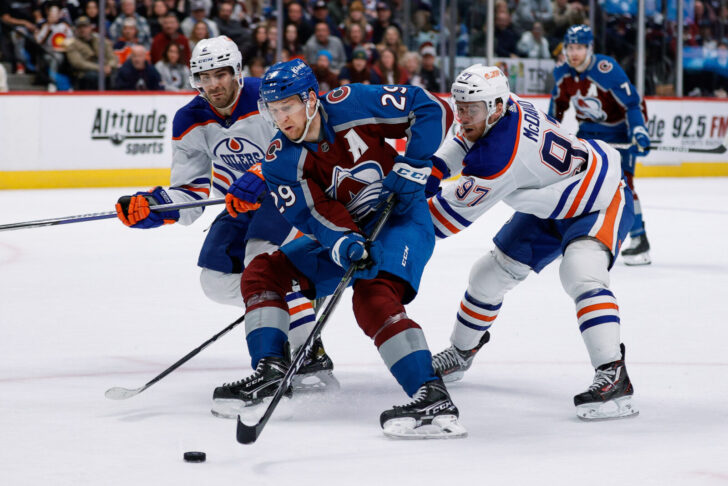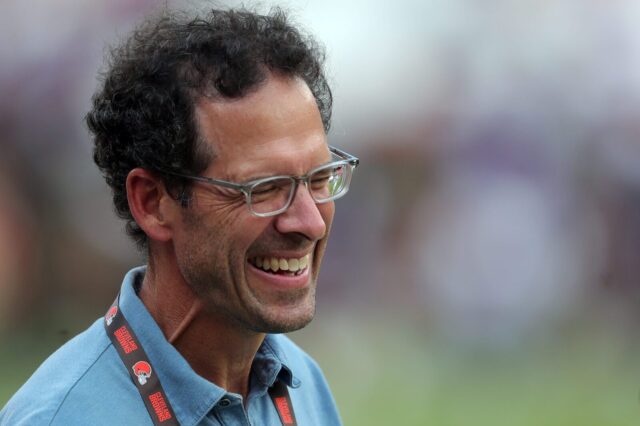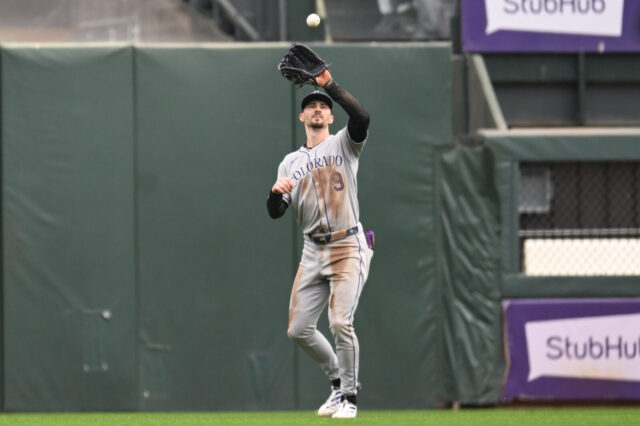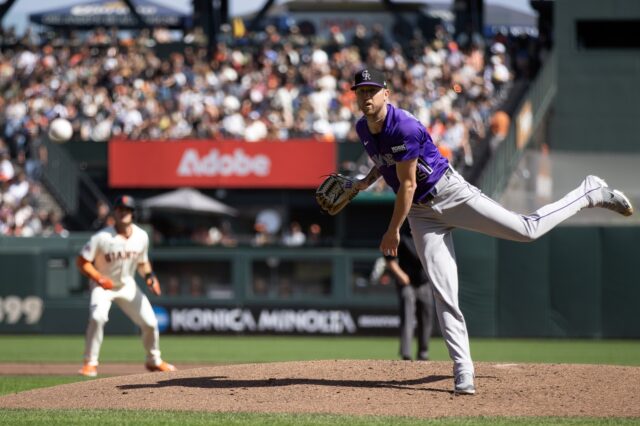Strike 1: Rest assured that the defending Stanley Cup champions aren’t going to go down without a fight. They’ve gone about proving that recently. Coming off a short offseason and all throughout a season plagued by unending injuries, the Colorado Avalanche have kept battling.
You have to wonder how much fight is left.
A year after winning the Cup, the Avs aren’t yet a lock to make the NHL playoff field this season. After beating Edmonton 6-5 in overtime for their third straight win, they still sit in third place in the Central Division, just two points ahead of Minnesota. They need to stay ahead of the Wild to avoid slipping back into the wild card race, where they currently trail the Oilers and would be fending off Calgary, who is just four points behind them. So at the moment, Colorado would be in the playoff field, but nothing is a not a lock. They’re still closer to ninth place than they are to first.
There are healthy and perhaps hungrier outfits like Dallas and Winnipeg ahead of them, each poised to give winning this year’s Stanley Cup their best shot, too.
It’s not certain if these Avs really have a best shot left in their collective tank. There’s no doubt they’ll empty that tank in order to try to repeat. But you see it all the time in basketball. A team spends every bit of energy they have to wipe out a 20-point deficit, only to find themselves running on fumes as their opponents put the game away late. A similar scenario could be unfolding with the Avs as they try to claw their way up the Western Conference standings with less than 30 games left in the regular season.
This team does not know how to punt. With the NHL trade deadline just less than two weeks away, it’s likely the organization will make a deal to reinforce this roster for a playoff sprint. Hopefully it’s not a deal that mortgages the future in any way just for the sake of 2023.
Think about it. Would it be so awful if Colorado missed the postseason this year?
Before you drop your gloves at the thought, keep in mind that missing the postseason this year could have serious benefits for the immediate future.
Given what they’ve had to deal with, perhaps a longer offseason that allows key players like Gabe Landeskog and others to get completely, 100% healthy and mentally rejuvenated wouldn’t be so terrible. Nearly every key Avs player has missed significant ice time this season, due in part to not having been able to get totally healed up during the Summer of Cup. Actual rest could do this group some good.
Mentally, too. Perhaps watching the rivals like Dallas and Las Vegas battle and grind toward the Cup would reignite some fire within? Imagine Nathan MacKinnon having to watch Joe Pavelski hoist his Cup.
Most importantly, getting healed up would allow the Avs to enter next season without questions at key positions. For instance, it’s well documented by now that the knee injury/surgery that has cost Landeskog this entire season occurred last season, and the short off season didn’t allow him time to heal. In retrospect, it was probably worth it, considering the ultimate prize. But the entire team has paid for it this season. It’d be nice to put and end to all this injury stuff and start fresh.
On the plus side, the spate of injuries has forced the Colorado coaches to give minutes to young prospects to not only find out if they have a future with this franchise, but to also look closer at their deep roster and see where specific spots might afford them the ability to make deals from a position of strength.
While another Cup run and another parade would be awesome, it’s more likely to happen in the summer of 2024 if this team can rest, heal up and get re-energized over the summer of 2023.
Strike 2: A year ago at this time, CSU basketball fans were more than a little eager to see the regular season wrap up, get the conference tournament over with, and see where their highly touted team was going to wind up being seeded and who they were going to play in the first round of the “Big Dance,” the NCAA men’s basketball tournament.
What a difference one year – and one player – makes.
Last March, Niko Medved’s squad finished second in the MW standings behind Boise State, got knocked out of the MW tournament in the second round by San Diego State and sat at 25-5 overall as they awaited their NCAA fate. Based on their regular season success – including wins over nationally ranked Creighton, St. Mary’s and SDSU, the Rams earned a No. 5 seed in March Madness. That was a lofty perch for a team that didn’t win their mid-major conference.
Even with the favorable seeding and a No. 5 v No. 12 match up with lightly regarded (at the time) Michigan, the Rams were ousted in the first round 75-63 by the Wolverines. Still, for CSU basketball fans, it was easy to see the needle pointing upward for the future. The major concern was keeping head coach Niko Medved, considered a rising star in the coaching ranks, from taking a bigger gig.
As the man says, not so fast my friend.
This year, without the services of current Memphis Grizzlies forward David Roddy and hampered by nagging injuries, like the foot and ankle issues that have slowed standout point guard Isaiah Stevens some, the Rams are battling with rival Wyoming to stay out of the Mountain West cellar, hopeful they can win at least two of their final four regular season games and be in position to take a Hail Mary shot in the MW tournament.
And no one is talking about Medved leaving CSU anytime soon.
Unless the Rams win all four of their remaining games against teams that have already beaten them this season (including Tuesday night’s tilt at MW leader and 21st-ranked San Diego State) this year’s Rams are going to finish under .500 and out of postseason consideration, unless they pull off a miracle in Las Vegas and win the MW tournament.
By any measure, the season (thus far) has been a big disappointment.
Most importantly, where do the Rams go from here?
Assuming their season ends in the conference tournament, what happens in Vegas should not stay in Vegas. It’s up to Medved to restock and re-energize his program. With Stevens sticking around for the 2022-23 season, this was not supposed to be a rebuilding year. Clearly Roddy meant even more to the program than anyone realized at the time.
Can Jalen Lake become the next Roddy? Can Isaiah Riveria replace Stevens? Or can Medved recruit another future NBA forward and give the Rams the juice they need to get back near the top of a very good Mountain West?
Stay tuned.
Strike 3: Picture a warm September evening, and it’s the top of the ninth inning at Coors Field. Leading 1-0, Rockies ace German Marquez is trying to complete a shut-out win over the Chicago Cubs. If the Rockies win, they’ll move a game north of .500 and stay a game ahead of the Milwaukee Brewers for the final National League wild card berth.
The Cubs lead off man, Nico Hoerner, battles Marquez through an eight-pitch at bat and draws a lead off walk. Rockies Manager Bud Black opts to stay with his starting pitcher, who has thrown just 92 pitches to this point. Closer Daniel Bard threw an inning in each of the last two nights, so he’s not available for this game. It’s all on German.
Hoerner is a base stealing threat to be sure. He already has 34 of them on the season (taking full advantage of MLB’s larger bases rule implemented this season.) Coming to the plate is Cubs star shortstop Dansby Swanson, who already has two of the Cubs four hits on the night. Getting Hoerner into scoring position for Swanson is something the Rockies desperately want to avoid. No one is expecting the Cubs to sacrifice bunt in this situation, either.
Marquez is fully aware of all of this. But his ability to help foil the impending stolen base attempt is now extremely limited.
Keep in mind that for half his life, Marquez has been on the mound countless situations just like this, free to do everything he could to prevent a stolen base. He had been free to not only make unlimited pick off throws to first base, but also do things like step back off the pitching rubber, bluff a throw, whatever he could do to disrupt the timing of a known base stealing threat.
Only this year, he’s not allowed to do so.
In this imaginary scenario – and many many many real ones that will occur just like this during the upcoming season – Major League Baseball has decided to put handcuffs on the guys on the mound. Pitchers can’t sell out to keep runners from stealing second base anymore. In the name of speeding up the game for viewers with short attention spans, MLB has made it illegal to “disengage” from the pitching rubber in any manner more than twice per at bat. That includes not only throws to first (or second) but moments when the pitcher simply wants to break up a baserunners rhythm by stepping off and faking a throw. It also counts against the pitcher if a bug flies into his eye and he steps off the rubber to swat it away, or to wipe sweat from his brow, or simply because he wants a new baseball that feels better in his hand. He can’t do any of that anymore, even though the vast majority or major league pitchers have been doing things one way for their entire mound lives.
“Disengaging” more than twice per at bat will result in a balk, moving all runners up a base.
So in this imaginary (but real life) scenario, even in games with serious playoff implications, pitchers like Marquez can’t risk stepping off to wipe sweat from his forehead. He can’t step off the rubber to try to disrupt the baserunner. And he can’t throw to first a second time or Hoerner will know that he can be off and running on the next pitch with little or no chance that Marquez will risk being called for a balk if he violates this new set of restrictions. (If a pitcher dares to make a third pick off throw to any base, it must result in an out or the balk will be called.)
The irony of all this is that by allowing Hoerner a far easier shot at stealing second, it will also increase the odds that the Cubs tie the game and send it into extra innings. On a school night.
So much for speeding up the game.
Another example of MLB finding a solution without a problem.





